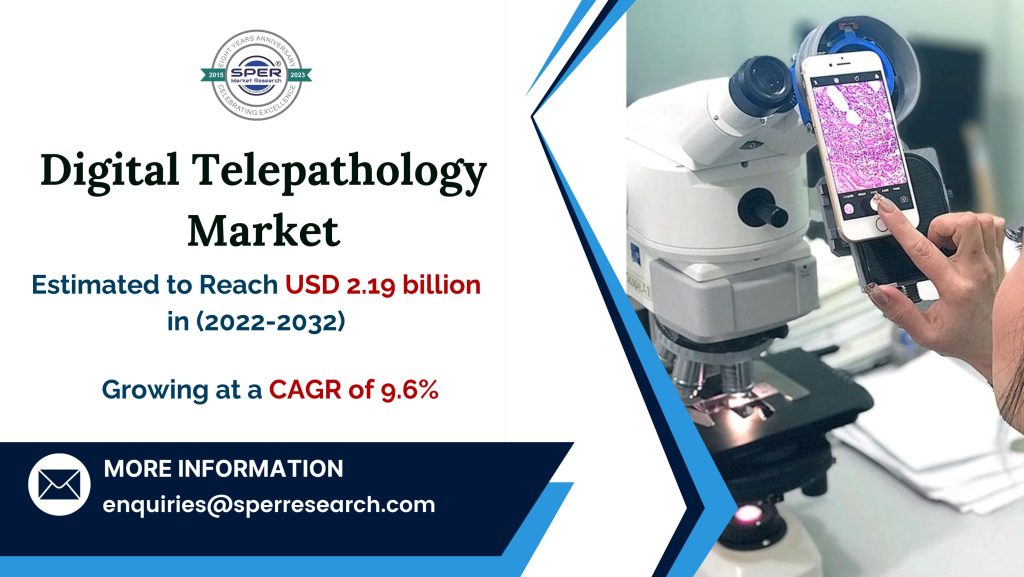Digital Telepathology Market Growth, Share, Global Industry Trends, Revenue, Challenges, Future Opportunities and Competitive Analysis 2032: SPER Market Research

The study of diseases is known as pathology, and it is one of the most important areas of diagnostics and treatment. Its main focus is on investigating different illnesses and determining their causes and origins. It is also carried out by looking at body tissues, organs, and fluids. Currently, it is separated into eight important fields of study. With the emergence of information technology and the digital age, the field of digital telepathology has grown. As the name suggests, it’s pathology using telecom technology. Digital telepathology is usually done at a distance, in contrast to general pathology, which is usually done near to the patient. Pathology image-rich data is transferred over long distances for study, teaching, and diagnosis.
According to SPER market research, ‘Digital Telepathology Market Size- By Type, By Application, By End User- Regional Outlook, Competitive Strategies and Segment Forecast to 2032’ state that the Global Digital Telepathology Market is predicted to reach USD 2.19 billion by 2032 with a CAGR of 9.6%.
One of the main forces behind the growth of the digital telepathology industry may well be the global information technology wave. Although poorer nations are increasingly becoming more connected to the Internet, Western nations already have a robust digital infrastructure. In remote parts of the nation and around the globe, pathologists are able to examine, investigate, and diagnose patients. The convenience and flexibility of getting a second opinion is a second consideration. Increased digitization in the realm of research is anticipated to be the third factor. Histopathology, medical education, and even frozen section specimen inspection can benefit from the use of digital pathology. Additionally, pathologists might convert physical data into digital files using digital software, doing away with the requirement for physical storage. They would also be able to save expenses and improve productivity.
The primary obstacle confronting the digital telepathology sector is its high cost. In developing nations, the cost of digital telepathology equipment presents a challenge. Typically, government subsidies are not accessible, which makes the first investment challenging. A further concern is worries about regulatory compliance. Since digital telepathology straddles the boundary between technology and medicine, regulations may vary by nation. Pathologists might also be against this. Nowadays, very few pathologists are able to properly use these methods, and many are hesitant to believe the findings. These are some of the reasons behind the small size of the digital telepathology market.
Request For Free Sample Report @ https://www.sperresearch.com/report-store/digital-telepathology-market.aspx?sample=1
Government agencies from several nations, academic institutions, and numerous pharmaceutical and biotech companies concentrated on efficient and quick technologies for precise COVID-19 detection as well as the creation of vaccines and novel treatments to fight the pandemic during the COVID-19 outbreak. At a period when many histology departments were already overworked and underfunded, COVID-19 tested diagnostic services. It also had a major effect on regular pathology services. Digital telepathology played a crucial role in safeguarding pathology-based research and healthcare services during the pandemic.
Digital Telepathology Market Key Players:
Geographically, North America dominated the global market due to growing government initiatives that resulted in the development of technologically advanced pathologies. As part of the Early Access Programme, PathAI released AISight, a digital pathology platform, in 13 of the nation’s top health systems, independent pathology organisations, and reference laboratories in March 2023. Additionally, some of the key market players are Olympus Corporation, OptraSCAN, Philips Healthcare, Ventana Medical Systems Inc. and others.
Digital Telepathology Market Segmentation:
The SPER Market Research report seeks to give market dynamics, demand, and supply forecasts for the years up to 2032. This report contains statistics on product type segment growth estimates and forecasts.
By Type: Based on the Type, Global Digital Telepathology Market is segmented as; Education, Medical, Other.
By Application: Based on the Application, Global Digital Telepathology Market is segmented as; Diagnosis, Education, Research, Others.
By End User: Based on the End User, Global Digital Telepathology Market is segmented as; Academic Institutes, Diagnostic Centers and Pathology Clinics, Hospital, Pharmaceutical and Biotech Companies, Research Organizations, Others.
By Region: The largest market is in North America, where moderate growth is anticipated over the following ten years. This is brought on by a robust healthcare system, laws like the Affordable Care Act, a high incidence of different cancers, and an aging population that need medical attention. Additionally, it is assisted by top-notch medical research and education facilities, quick technological uptake, and the availability of government compensation in these crucial fields in North America. Due to industrialisation and investment prospects in healthcare facilities, Canada has a significant development potential.
This study also encompasses various drivers and restraining factors of this market for the forecast period. Various growth opportunities are also discussed in the report.
For More Information, refer to below link:-
Digital Telepathology Market Scope
Related Reports:
Follow Us –
LinkedIn | Instagram | Facebook | Twitter
Contact Us:
Sara Lopes, Business Consultant – U.S.A.
SPER Market Research
+1-347-460-2899





